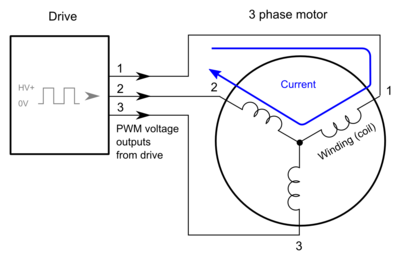3-level PWM vs 2-level PWM
Typical motor drive based controls motor coil current by outputting PWM signal which is basically high frequency on/off switching of HV DC bus voltage. Switching voltage on and off yields low heat dissipation from drive compared to linear amplifier designs. Typical PWM based drive typically operates around 90% power conversion efficiency while linear amplifiers rarely operate above 50% efficiency.
PWM switching schemes
In motor control, two most common switching schemes are conventional 2-level a.k.a. antiphase PWM and more modern 3-level PWM.
- 2 level PWM
- The outputs of antiphase or 2-level PWM are inversions of each other. The effective output voltage is the average of voltage differential over inductive load such as motor coil. Coil is driven either full positive or full negative voltage of HV DC bus. Full positive voltage induces maximum current change in positive direction and vice versa. Switching between positive and negative output yields sawtooth like current ripple over coil.
- 3 level PWM
- The output of 3-level PWM are in-phase with each other which yields three distinct voltage levels of voltage differential over the load. The third voltage level is zero voltage which features lower current rate of change in the coil yielding lower total current ripple.
Simulated waveforms
These simulations display a case where one coil is being driven with 2 and 3 level PWMs. Coil is being driven with PWM outputs where duty cycles are modulated sinusoidally to create sinusoidal current. All simulation parameters are kept same, only difference is the switching scheme.
Frequency 20 kHz, modulation depth 0.25, sinusoidal frequency 300 Hz, HV DC bus voltage 300 V, load inductance 3.3 mH, load resistance 10 ohm.
2-level PWM
3-level PWM
Effects
While 3 level PWM may require more sophisticated control circuity, it gives benefits of notably reduced ripple current which has benefits such as reduced motor heat dissipation and longer motor bearing life. Current ripple directly relates wearing bearings due to eddy currents in metallic materials.
The ripple reduction in the worst case is 1:4 and in the best case (zero output) it is reduced to zero.
In no event the Product Information or parts hereof shall be regarded as guarantee of conditions or characteristics. The Product Information or any part thereof may also not be regarded as a warranty of any kind. No liability of any kind shall be assumed by Author with respect to Product Information or any use made by you thereof, nor shall Author indemnify you against or be liable for any third party claims with respect to such information or any use thereof.
As content of this Wiki may be edited by user community, Granite Devices Oy or it's affiliates do not take any responsibility of the contents of this Wiki. Use information at your own risk. However, Granite Devices staff attempts to review all changes made to this Wiki and keep information trustworthy.
Without written consent, Granite Devices' Products or Intellectual Property shall not be used in situations or installations where living beings, material property, or immaterial property could be harmed by the operation, features or failures of Product. Products may only be used in a way where hazards like moving parts, electric shock, laser radiation, or fire can't be realized even if the content of this Wiki would suggest otherwise.


